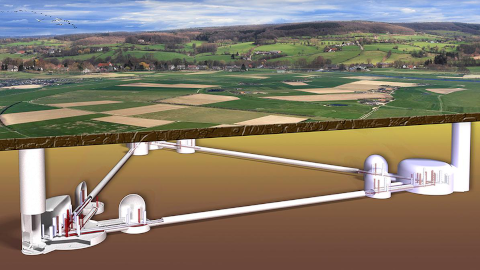Einstein Telescope approved for ESFRI Roadmap 2021

The European Strategy Forum on Research Infrastructures decided to include the Einstein Telescope in the 2021 upgrade of its roadmap. This confirms the relevance of this major international project for a next generation gravitational waves, with the participation of the IFAE and the ICE, at the UAB.
06/07/2021
On June 30th, the European Strategy Forum on Research Infrastructures (ESFRI) decided to include the Einstein Telescope (ET) in the 2021 upgrade of its roadmap. This confirms the relevance of this major international project for a next generation gravitational waves observatory for the future of research infrastructures in Europe and gravitational wave research at global level.
The Italian government submitted the proposal on September 9th, 2020 supported by the Netherlands, Belgium, Poland and Spain. The Einstein Telescope was identified after a long and accurate process of evaluation and selection. During the ESFRI Assembly meeting, delegates officially decided to include the Einstein Telescope in the Roadmap. This official European approval now brings the project into a new phase. The scientific Institutions involved from ten countries (Belgium, Germany, Hungary, Italy, Norway, Spain, Switzerland, Poland, The Netherland, UK) will now have to intensify their research and development work on the Einstein Telescope and gravitational waves. It will also speed up the ongoing subsurface studies for the characterization and evaluation of the candidate sites that could host the underground infrastructure.
The Spanish involvement in the Einstein Telescope
“This is a great success for the GW community in Spain as a whole”- says IFAE researcher Mario Martinez, member of the Einstein Telescope Steering Committee that prepared the ESFRI candidature.
An effort was put in place back on early 2020 with the aim of gathering support for the Einstein Telescope among the Spanish research groups. It was a great success with up to 23 institutions expressing a strong interest in a participation in the project, including four ICTs (Singular Research Infrastructures) in Spain. Altogether, this translated into Spain formally supporting the ESFRI candidature. Now ET is a recognized infrastructure in the 2021 ESFRI roadmap.
The interest of Spain on Gravitational Waves (GW) Physics with ground-based experiments has increased enormously during the last decade. Spanish scientists have contributed to the studies determining the physics potential of ET and are now part of the working groups designing the experiment. A number of Spanish institutions already signed a memorandum of understanding for contributing to the construction of the experiment including the Consejo Superior de Investigaciones Científicas (CSIC), the Institut de Ciències de l’Espai (ICE) de Barcelona, the Institut de Física d’Altes Energies (IFAE) de Barcelona, the Instituto de Estructura de la Materia (IEM) de Madrid, the Instituto de Física Teórica (IFT) de la Universidad Autónoma de Madrid, the Universitat de Barcelona (ICCUB), the Universitat de les Illes Balears (UIB), the Universitat de València (UV).
With the ESFRI recognition one can foresee the growth of the ET community and a fast and energetic involvement of the Spanish institutions in the design and construction of the experiment. In addition to a top physics program, that will change our view and understanding of the universe, the ET project offers great opportunities in terms of technological developments and industrial returns.
A new window on the universe
The Einstein Telescope is a future underground observatory for gravitational waves. The instrument will be much more sensitive than existing gravitational-wave detectors. Therefore, the observatory will enable scientists to peek into the ‘dark ages’ of the universe for the first time.
Gravitational waves were detected for the first time in 2015 and offer a new way of studying the universe. Until their first detection, scientists could only study the universe by looking at light or radiation, but with gravitational waves they can observe vibrations of spacetime itself. Although the existence of gravitational waves was already predicted by Albert Einstein a hundred years ago, he did not expect it was possible to ever detect them. Yet with the mind blowing technological developments of the last century, scientists and engineers have managed to reach the sensitivity and precision that is needed to observe them. This opened a new era in the study of the universe, the era of gravitational wave and multimessenger astronomy, and led to a Nobel prize in 2017. The Einstein Telescope will lead to many more unimaginable discoveries in the future in this new field of research.
About ESFRI and the ESFRI Roadmap
ESFRI, the European Strategy Forum on Research Infrastructures, is a strategic instrument to develop the scientific integration of Europe and to strengthen its international outreach. The mission of ESFRI is to support a coherent and strategy-led approach to policymaking on research infrastructures in Europe, and to facilitate multilateral initiatives leading to the better use and development of research infrastructures, at EU and international level. ESFRI’s delegates are nominated by the Research Ministers of the Member and Associate Countries and include a representative of the Commission. The ESFRI Roadmap identifies the most promising European scientific structures on the basis of an in-depth evaluation and selection procedure, and includes the ESFRI Projects, i.e. new research infrastructures under construction, and the ESFRI Landmarks, i.e. research infrastructures already implemented with success. All previous updates of the ESFRI Roadmap have proved to be very influential and have provided strategic guidance for investment by member states and associated countries, even beyond the scope of research infrastructures.